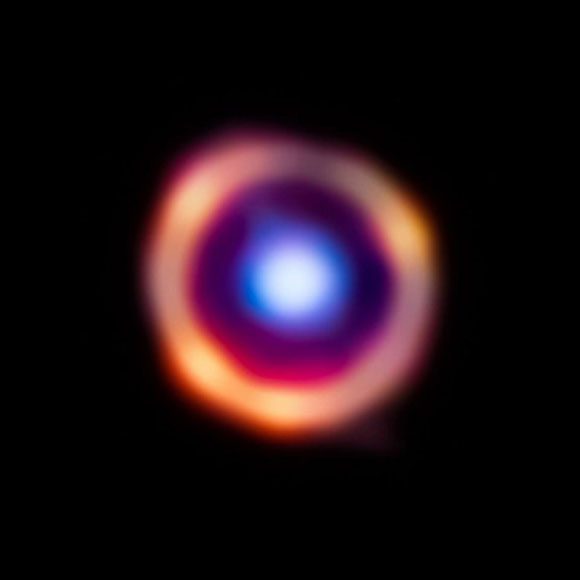Under the watchful eye of the James Webb Space Telescope, a “time-traveling” image of a galaxy from the cosmic dawn has revealed the oldest “seeds of life” ever recorded.
This groundbreaking discovery was made in SPT0418-47, a galaxy cloaked in dust that has existed since the universe was only about 10% of its current age.
According to Sci-News, the research team led by Professor Joaquin Vieira from the University of Illinois at Urbana-Champaign (USA) analyzed data from James Webb (developed and primarily operated by NASA) and found the presence of polycyclic aromatic hydrocarbons (PAHs) mingled within the dust particles of the glowing galaxy at infrared wavelengths.

Galaxy SPT0418-47 glowing red with organic molecules illuminated by orange light, while a foreground galaxy is marked in blue – (Photo: NASA/ESA/CSA).
SPT0418-47 is located 12 billion light-years away from Earth, meaning it takes 12 billion years for its light to reach us. This implies that we are observing the galaxy as it was 12 billion years ago, amidst a region of the universe from a very distant past.
Therefore, the PAHs it possesses – complex organic molecules that play a fundamental role in today’s life – are also the oldest organic molecules ever found by humanity.
Spectroscopic data from the galaxy also shows that the interstellar gas within it is enriched with heavy elements. This means that the galaxy has undergone a dynamic process for a very long time, with many generations of stars being born and dying, according to a paper published in the scientific journal Nature.
The principle of cosmic development – initially consisting of a few sparse elements – lies in the continuous creation of more elements by the “reactors” in the cores of stars. When a star reaches the end of its life and explodes, it contributes new elements that help diversify the chemical composition of the universe.
Thus, this study adds to the growing evidence that the universe evolved very rapidly in its early stages, a frontier that scientists continually hope to explore further to explain our very existence.
At the same time, it also provides a new method for exploring the past, through the dust particles surrounding galaxies, which absorb half of the radiation emitted by nearby stars throughout history and glow under the lenses of infrared observatories.


















































